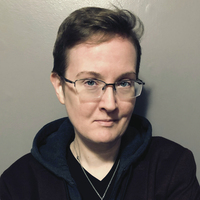It’s Not a Demon…But How Do We Know?
Readers, please enjoy this guest blog post by M. Belanger, author of several titles, including The Ghost Hunter’s Survival Guide, Walking the Twilight Path, and the new Dictionary of Demons: Expanded & Revised.

Let’s face it. Demons are the low-hanging fruit of paranormal reality television, the over-used “gotcha” guaranteed to keep folks glued to the screen between commercial breaks. Even outside of TV-land, far too many paranormal investigators toss out the word “demon” the instant they encounter something they deem negative, usually defining negative as something they themselves personally find frightening or unsettling.
But there are plenty of reasons why non-demonic spirits might be perceived as malevolent entities.
The first thing to consider when assessing a supposedly negative haunting is why the spirit might be acting out in the first place. Spirits, human and otherwise, rarely interact with the living unless they want or need something. Sometimes it’s as simple as wanting attention, but in certain cases, spirits may be in distress because of a circumstance for which they feel the living are responsible—or at least have it in their power to resolve.
A good example includes nature spirits (termed “elementals” by some paranormal investigators, not to be confused with the elemental spirits of ceremonial magick like salamanders and sylphs). When human activity has caused harm to the land or a specific natural feature important to those spirits, they will frequently lash out—and understandably so. This aggression does not make them demons, and in fact, compassionate communication typically resolves the issue. But when investigators consistently work on the assumption that all aggressive spirits are demons by default, the opportunity for peaceable resolution is lost.
Even human dead may be mistaken as demonic by investigators who assume that all dark or otherwise malevolent spirits are demons. We only have to look at the daily news to see that not all human beings are good. Some of them are downright rotten, and contrary to some starry-eyed beliefs widely promoted during the Spiritualist movement, human spirits do not automatically become enlightened once they pass on. If a human was a terrible person in life, they can carry that over in death, lashing out and causing harm for no better reason than they want to.
But we have inherited this word demon for a reason, right? And it’s not purely a Christian concept, despite how widely Christianized it has become in popular media. There are demons in virtually all world religions, and the Biblical tradition of demons owes a great deal to the religion and folklore of the Ancient Near East, long before Jewish monotheism made it to the world stage.
If we look to the Akkadian Maqlû Texts (at least three millennia old) we encounter strikingly familiar concepts of possession, exorcism, and demonic attack. From these texts alone, we can see that humanity’s belief in demons is older than widespread beliefs in Satan or even Hell. But if demons aren’t literal minions of the Devil, then what are they supposed to be—assuming they exist at all?
As I was working on my Dictionary of Demons, part of my research involved comparing the concept of the demonic as it is expressed in religions, mythology, and folklore from around the world. From that research, I can say there are a few defining qualities demons have in common:
- Demons are not human spirits and never were.
- Demons are supernaturally intelligent, often with an “evil genius” level of cunning.
- Demons are inherently malevolent. They thrive on doing harm.
- Demons make targets of humans, fixating on or outright possessing them.
The whys and wherefores of their motivations vary depending on the time period, religion, or culture sourced, as do their origin and reason for existence. But if we are to be accurate with our use of the term demon in the paranormal, no haunting should be described as demonic unless all four qualities listed above are observed and confirmed.
As to what you do after that, it depends on your own beliefs.
Our thanks to M. for her guest post! For more from M. Belanger, read her article, “Call Me By Your Name: Demons, Possession, and Exorcism.”









